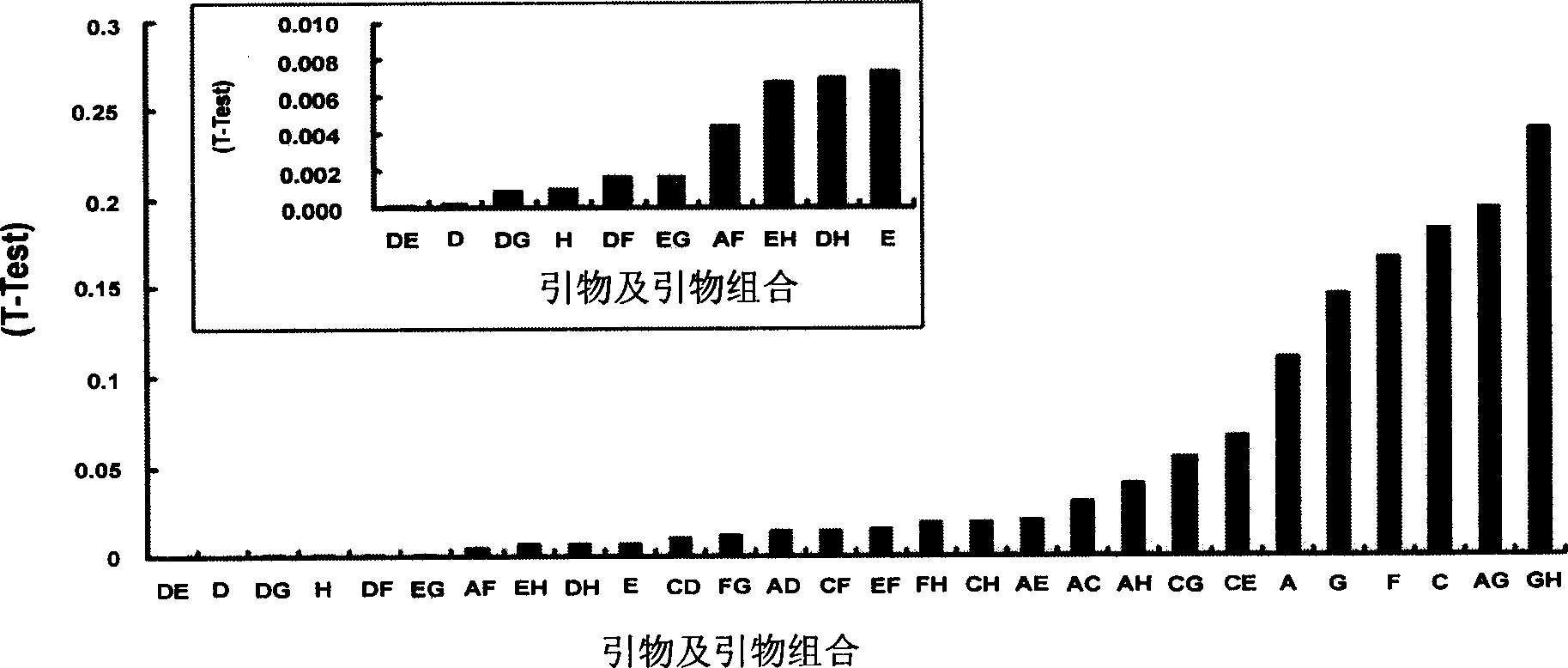Method of auxiliary screening cold resistant paddy rice and its special primer
A rice and cold-resistant technology, applied in the field of auxiliary screening of cold-resistant rice, can solve problems such as genetic bottlenecks, and achieve the effects of simple operation, shortening the breeding cycle, and speeding up the breeding speed.
- Summary
- Abstract
- Description
- Claims
- Application Information
AI Technical Summary
Problems solved by technology
Method used
Image
Examples
Embodiment 1
[0019] Example 1, Discovery of special primers and molecular markers
[0020] First, Jiangxi Dongxiang common wild rice was backcrossed and self-crossed with the ultra-high-yield variety Guichao 2, and a high-generation backcross population (BC 4 f 2 group), and identify the cold tolerance of this group in bud stage. The specific identification method is: soak the rice seeds with 5% sodium hypochlorite for 20 minutes, then rinse with water for 3-4 times, then soak the seeds at 37°C for 1 day, then place the seeds on the filter paper soaked in water in a glass test tube, put the test tube into Germinate in the light culture room (28°C day / 25°C night, 12h light and 12h dark every day, 83% relative humidity), and when the buds grow to about 5mm, select 100 robust and consistent buds and place them in a glass with a diameter of 4cm and a height of 9.5cm in a test tube. Put the test tube in a refrigerator at 4-5°C for 5 days at low temperature, then move the young shoots to the ...
Embodiment 2
[0026] Example 2, the amplification products (molecular markers) of p8-3, p12, p16, p18, p21, p22 and p32 in IL112 and Jiangxi Dongxiang common wild rice are related to the cold tolerance of the population
[0027] First, according to the method of Example 1, the F strain constructed by IL112 and Guichao 2 was backcrossed and self-crossed. 2∶3 The cold tolerance of the budding stage of the population was identified, and the live seedling rate of each strain was counted; at the same time, each F 2 Genomic DNA of single plant, carry out PCR amplification with the amplified product (molecular marker) of primer p8-3, p12, p16, p18, p21, p22 and p32 in IL112 and Jiangxi Dongxiang common wild rice in embodiment 1 as Marker Increase (PCR amplification reaction and electrophoresis condition are the same as embodiment 1) detect the band type of each strain, analyze genotype, analyze the relation of genotype and bud stage cold tolerance with T-Test method, the result finds: p8-3, p12 T...
Embodiment 3
[0030] Example 3, Feasibility verification of screening cold-tolerant rice with primer p21
[0031] Rice varieties (the following rice varieties except IL112 are all from the National Seed Resource Bank): IL112, 746, Yunfeng 7, Xiangjingnuo, Wan 88-1, Shangzhou 10, Miryang 111, Hexi 35, REIMEL, IR66746-76-3-2, 9505-138, Guichao 2, 03A-11, 03A-9, Zhongyou 13, 37760, Shuiyuan 349, Shuiyuan 332, Shuiyuan 287, VISTA, TP34 and SR64446-1.
[0032] At first by the method in embodiment 1, 20 rice varieties are carried out bud stage cold tolerance appraisal, appraisal result is as table 3:
[0033] rice variety
PUM
 Login to View More
Login to View More Abstract
Description
Claims
Application Information
 Login to View More
Login to View More - R&D
- Intellectual Property
- Life Sciences
- Materials
- Tech Scout
- Unparalleled Data Quality
- Higher Quality Content
- 60% Fewer Hallucinations
Browse by: Latest US Patents, China's latest patents, Technical Efficacy Thesaurus, Application Domain, Technology Topic, Popular Technical Reports.
© 2025 PatSnap. All rights reserved.Legal|Privacy policy|Modern Slavery Act Transparency Statement|Sitemap|About US| Contact US: help@patsnap.com



